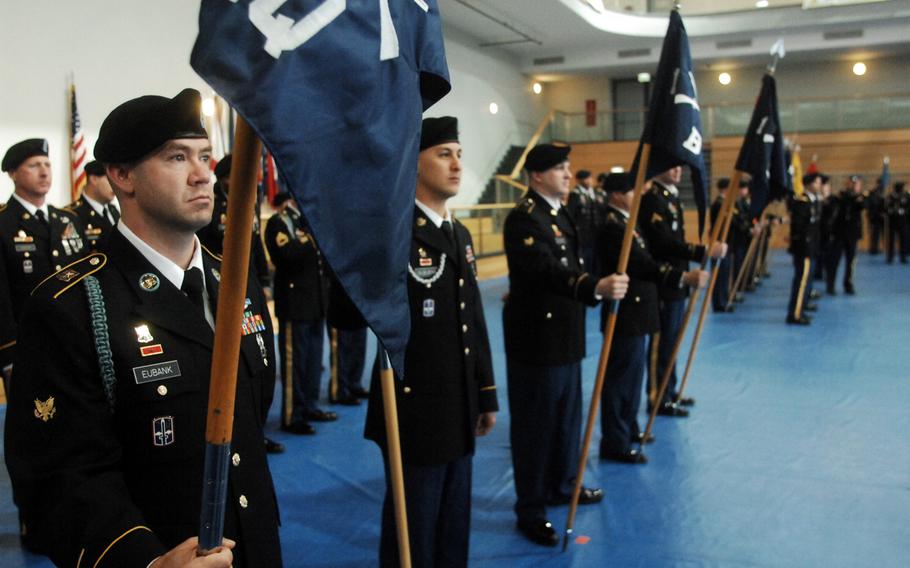Europe
Final flourish as 172nd inactivates in Grafenwöhr
Stars and Stripes May 31, 2013

Spc. Nicklas Eubank of the 1st Battalion, 2nd Infantry Regiment, stands in formation before Friday's inactivation ceremony for the 172nd Separate Infantry Brigade in Grafenwoehr, Germany. The brigade is the second to inactivate in Europe in the past 18 months as part of a larger drawdown of Army forces on the continent. (Steven Beardsley/Stars and Stripes)
GRAFENWÖHR, Germany — In a final flourish, the 172nd Separate Infantry Brigade cased its colors on Friday and inactivated for the indefinite future, marking another milestone in the continued transformation of U.S. forces in Europe.
The brigade’s dissolution, and the loss of its roughly 3,800 soldiers to other units across the Army, leaves two brigade combat teams and an aviation brigade as the largest U.S. Army combat units on a continent that once hosted a number of division-level assets.
As smaller support units across U.S. Army Europe inactivate or return to the U.S. over the next three years, the Army’s presence here is expected to fall to 30,000 soldiers, part of an overall U.S. force of 69,000 on the continent.
During the Friday ceremony, soldiers from the brigade’s six battalions stood in formation as leaders cased unit flags. Brigade commander Col. Edward Bohnemann and Command Sgt. Maj. Michael Boom sheathed the brigade colors.
U.S. Army Europe commander Lt. Gen. Donald Campbell Jr. delivered brief remarks, noting the brigade’s two deployments under the 172nd patch, including an 11-month tour in eastern Afghanistan that ended last summer.
“The Blackhawk brigade accomplished everything that was asked of it with ease, but not without considerable sacrifice,” Campbell told an audience of hundreds inside the main post gymnasium.
The majority of the 172nd’s soldiers have already moved to other units, leaving less than 15 percent of the brigade’s full strength. Soldiers remain under the command and control of a single battalion and will continue to move out as they receive orders.
The Department of Defense announced in January 2012 that the brigade would be one of two in Germany — with the 170th Infantry Brigade in Baumholder — to inactivate as part of a wider drawdown in Europe.
Both units were considered “heavy” brigades for their allotment of armor battalions with Bradley Fighting Vehicles and M-1 Abrams main battle tanks.
The 170th inactivated in October. The last U.S. Abrams tanks were removed from Europe in April, a milestone after 69 years of American armor presence on the continent from the fighting of World War II to the Cold War posturing that followed.
The disappearance of American heavy armor leaves the wheeled, medium-armored Stryker as the primary combat vehicle for Army forces in Europe. The Stryker is the platform for the 2nd Cavalry Regiment, based on the Rose Barracks side of the Grafenwöhr garrison.
The 173rd Airborne Brigade Combat Team, a light infantry unit split between Italy and Grafenwöhr, is the other ground combat unit in Europe. The 12th Combat Aviation Brigade in Ansbach, Germany, provides air assault and lift capabilities for the theater.
The 172nd, like the 170th, had been identified for removal from Europe well before both were reflagged from division-organized brigades to separate brigades in 2008 and 2009, respectively. A 2010 Pentagon review called for both units to remain in Europe, but discussion of their removal continued.
The 2012 announcement came as the Pentagon unveiled a new global strategy that emphasized a greater military presence in Asia and a lighter footprint in Europe.
The inactivation of the 172nd also allows garrisons in Bamberg and Schweinfurt, Germany, to close by fall 2014, as planned.
The Army created the 172nd Infantry Brigade in August, 1917, and deployed it to France near the end of World War I. The brigade returned to the U.S. and transformed multiple times before deploying to Europe again, at the end of World War II.
It was inactivated three times in the following decades before its latest chapter began in 2008, when the Army reflagged the 2nd Brigade of the 1st Infantry Division and moved its headquarters from Schweinfurt to Grafenwöhr.
For Bohnemann, who led the brigade in its most recent deployment, announcement of its inactivation carried little surprise.
“We saw it coming with the end of the two wars in Iraq and Afghanistan,” Bohnemann said.
Twitter: @sjbeardsley